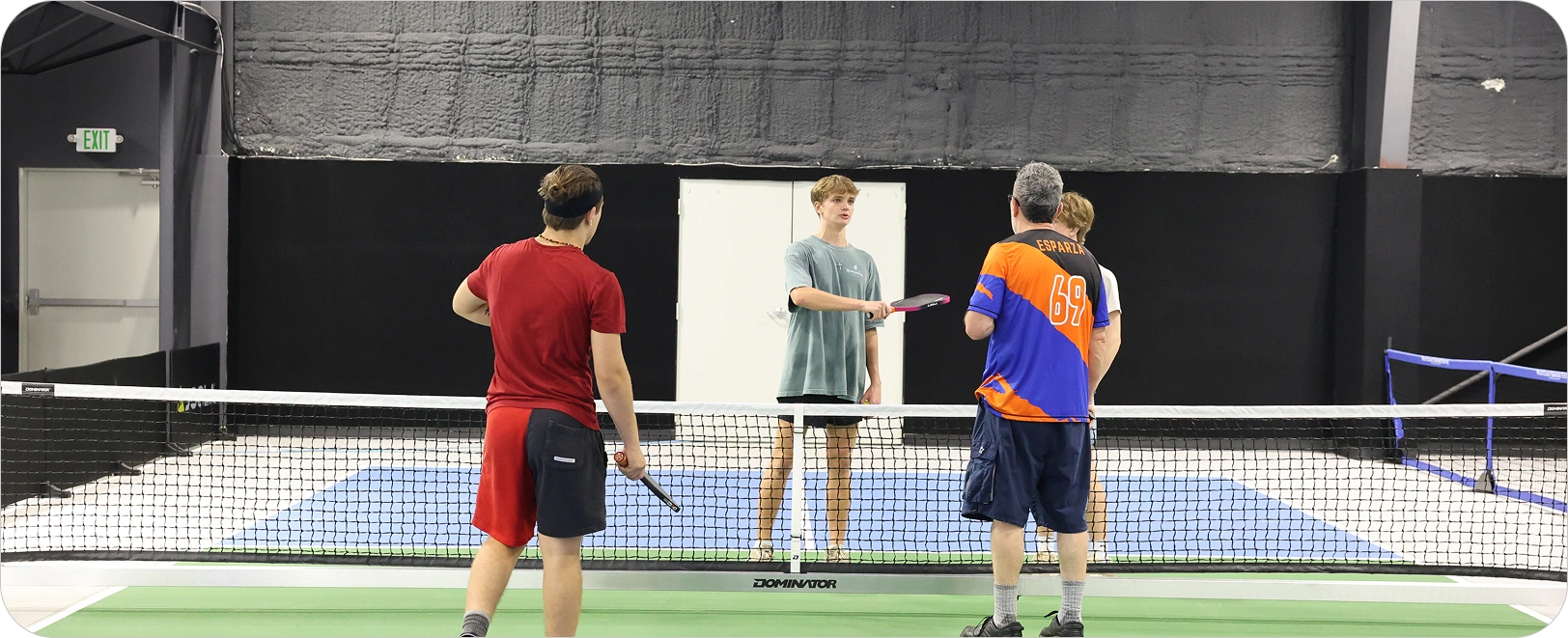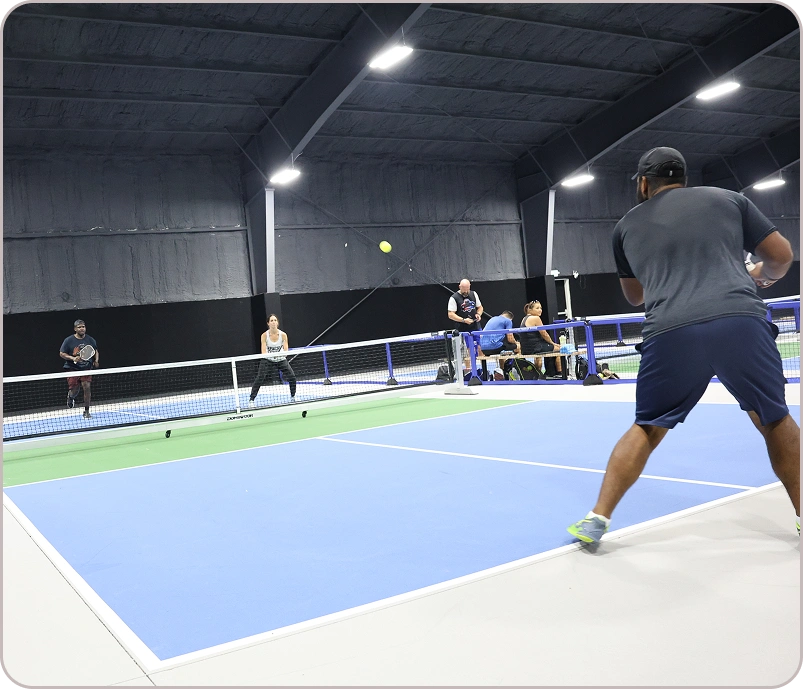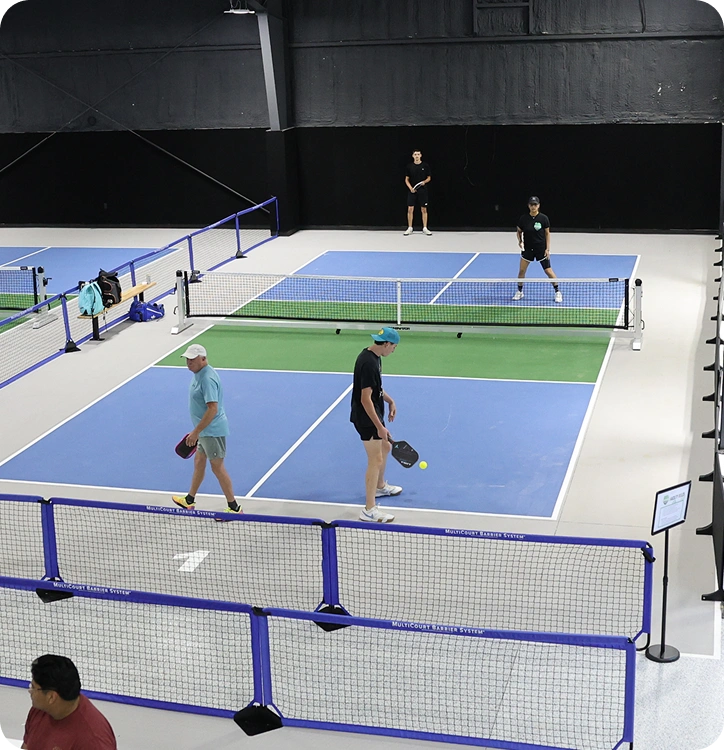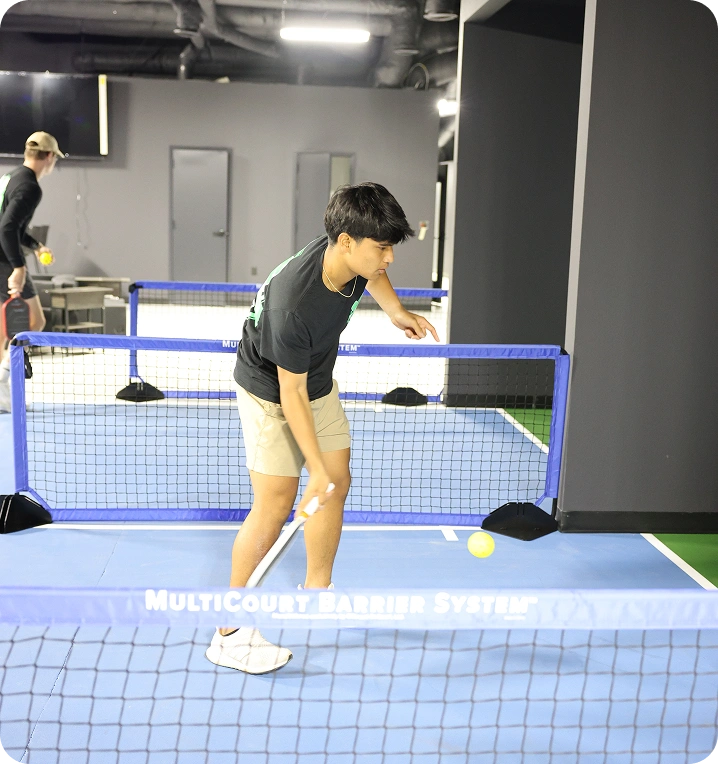Pickleball Rules
Overview of Basic Pickleball Rules
- Pickleball can be played as either doubles (two players per team) or singles, with doubles being the more common format.
- The same court size and rules apply to both game types.

Amateur Rules
Servings
- The server’s arm must move in an upward arc when striking the ball.
- The paddle must make contact with the ball below waist level.
- The paddle head must remain below the highest part of the wrist at the moment of contact.
- A ‘drop serve’ is allowed, where the above restrictions do not apply.
- When striking the ball, the server’s feet must not touch the court, the area beyond the imaginary extensions of the sideline or centerline, and at least one foot must be behind the baseline on the playing surface or ground.
- Serves must be made diagonally across the court, landing within the boundaries of the opposite diagonal service area.
- Each server is allowed only one serve attempt.

What is Service Sequence?
- In doubles, both players on the serving team get the chance to serve and score points until they commit a fault (except during the first service sequence of a new game).
- The first serve of each side-out starts from the right-hand court.
- If the serving team scores a point, the server switches sides and serves again from the left-hand court.
- The server continues alternating sides with each point scored until a fault is committed, ending their turn.
5. When the first server loses their serve, their partner takes over, serving from their correct side of the court (except during the first service sequence of a game).
6. The second server continues serving until their team commits a fault and the serve passes to the opposing team (side-out).
7. After a side-out, the first serve for the opposing team always starts from the right-hand court. Both players on that team get an opportunity to serve and score until two faults are committed.

Singles Rules:
In singles, the server serves from the right-hand court when their score is even and from the left-hand court when their score is odd.
Note: At the beginning of a new game, only one player on the serving team serves before faulting, after which the service passes to the receiving team.
Scoring
Traditional Side-Out Scoring:
- Points can only be scored by the serving team.
- Games are typically played to 11 points, with a win requiring a 2-point margin.
- Tournament games may be played to 15 or 21 points, also requiring a 2-point margin to win.
- If the serving team’s score is even (0, 2, 4, 6, 8, 10), the player who was the first server for that team will be positioned in the right-side court when serving or receiving.
- If the score is odd (1, 3, 5, 7, 9), that player will be positioned in the left-side court when serving or receiving.
Rally Scoring:
- A point is awarded after every rally, regardless of which team is serving.
- This scoring format rewards performance on each point.
TWO BOUNCE RULE
The Two Bounce Rule in pickleball stipulates that when the ball is served, the receiving team must allow it to bounce before returning it. Subsequently, the serving team must also let the ball bounce before making their return, resulting in two bounces.
Once the ball has bounced once on each team’s side, both teams are then free to either volley the ball (hit it before it bounces) or play it off a bounce (ground stroke). This rule effectively removes the advantage of serve-and-volley tactics and promotes longer rallies in the game.

What is Non-Volley Zone?

The non-volley zone, commonly known as “the kitchen,” is the area of the court that extends 7 feet on either side of the net. Within this zone, players are prohibited from volleying the ball, which helps prevent them from executing powerful smashes from close range.
If a player steps into the non-volley zone while attempting to volley the ball, or if their momentum causes them or anything they are wearing or carrying to touch the zone, it is considered a fault. Additionally, if a player is propelled into the non-volley zone after volleying, it is also deemed a fault, even if the volleyed ball is ruled dead before this occurs.
Players are allowed to be in the non-volley zone at any time, except when they are volleying the ball.
Line Calls
A ball that touches any line, with the exception of the non-volley zone line during a serve, is deemed “in.” However, if a serve makes contact with the non-volley zone line, it is considered short and results in a fault.
What the reasons behind Faults?
A fault is any action that halts play due to a rule violation.
- If the receiving team commits a fault, the serving team earns a point.
- If the serving team commits a fault, the server loses their serve or the opposing team gets a side out.
A fault occurs in the following situations:
- The serve lands outside the designated receiving court.
- The ball is hit into the net during the serve or any return.
- The ball is volleyed before it bounces on either side.
- The ball is hit out of bounds.
- A ball is volleyed from the non-volley zone.
- The ball bounces twice before the receiver strikes it.
- A player, their clothing, or any part of their paddle touches the net or its post while the ball is in play.
- A service rule is violated.
- A ball in play hits a player or anything they are wearing or carrying.
- A ball in play strikes any permanent object before bouncing on the court.

Determining the Serving Team
To decide which player or team has the first choice of side, service, or other options, any fair method can be employed. For example, you could write a “1” or “2” on the back of the score sheet to facilitate the decision-making process.
Frequently Asked Questions
A pickleball court measures 20 ft wide by 44 ft long. It’s divided by a centerline into right and left service courts, with a 34 in high net and two 7 ft “kitchen” (non‑volley) zones on either side of the net.
Serves must be made underhand, paddle below waist level, and struck so the ball lands diagonally in the opponent’s service court—clearing the non‑volley zone every time.
After the serve, the receiving side must let the ball bounce once, then the serving side must also let it bounce before volleys are allowed. This ensures at least two groundstrokes to start each rally.
The 7 ft area on each side of the net where you cannot volley (hit the ball in the air). You may enter the kitchen only after the ball bounces, and you must exit before volleying again.
Only the serving side can score points. Games are typically played to 11 points (win by 2), though some tournaments use 15 or 21. Server announcements use three numbers: server number, server score, opponent score.
Faults include: hitting the ball out of bounds; not clearing the net; volleying from inside or touching the kitchen; serving incorrectly (e.g., above waist, wrong court); and double‑bouncing.
At the moment of contact, neither foot may touch the non‑volley zone line or court. You must have at least one foot behind the baseline, and both feet must remain stationary until the ball is struck.
If the served ball touches the net but still lands in the correct service court, it’s a “let” and is replayed without penalty. If it lands out or in the kitchen, it is a fault.
Volleys (hitting the ball before it bounces) are permitted only when both feet are outside the non‑volley zone. You may step into the kitchen to play a bounced ball, but must exit before volleying.
The basic rules are identical, but in doubles the server rotation and partner positioning change: each team has two serves before side out (except at start of game), and partners alternate receiving and serving.

